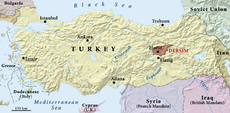- Dersim Massacre
-
Dersim Massacre[1] is a name given to the violent suppression during the Dersim Rebellion in the summer of 1937 and the spring of 1938 of the local population of Dersim, now called Tunceli Province (in Turkey). Tens of thousands of Alevi Kurds[2] were killed and thousands more forced into exile, depopulating the province. A key component of the Turkification process was the policy of massive population resettlement, a result of the 1934 Law on Resettlement ('İskân Kanunu' Law No.2510, 13 June 1934) [3] , a policy targeting the region of Dersim as one of its first test cases with disastrous consequences for the local population.[4] Three types of resettlement zones were defined in the resettlement law as follows:
- districts to be evacuated for health, economic, cultural, political and security reasons and where settlement was forbidden;
- districts where the population was to be transferred and resettled for the purposes of assimilation to Turkish culture; and,
- districts where an increase of the population having 'Turkish culture' was recommended.
Contents
Genocide controversy
It is controversial whether the massacre constitutes a genocide. It has been argued that, legally speaking, this is not the case. The massacre is argued to not constitute a genocide under International and Human Rights laws as the actions by the Turkish authorities were not aimed at the extermination of the Kurds as a people, but rather at the aforementioned resettlement and suppression.[5] Scholars have instead talked of an Ethnocide, due to the laws that the measures were based upon, which were directed against the Kurdish language and identity and not the extermination of Kurds as such. However, other scholars, particularly Kurdish political scientists have disagreed and called it the Dersim Genocide.[6]
Dersim genocide conference
Some researchers and parties, in particular the Kurds, consider the events as genocide. In 2008, the "Dersim ‘38 Conference" by PEN-Kurd reached the conclusion that Turkey was guilty of genocide not only of Alevis, but also Armenians, Assyrians, Greeks, non-Alevi Kurds and Jews, estimating that 50,000-80,000 were killed in the aftermath of the Dersim rebellion.[7] Other sources speak of around 80 000 killed during the rebellion, but only 10 000 killed in the aftermath.[7][8][9]
References
- ^ Susan Meiselas, Martin van Bruinessen, Kurdistan: in the shadow of history, Random House, 1997, p. 147.
- ^ The Suppression of the Dersim Rebellion in Turkey (1937-38) Page 4
- ^ Çağaptay, Soner (2002). "Reconfiguring the Turkish nation in the 1930s". Harvard. http://www.hks.harvard.edu/kokkalis/GSW4/CagaptayPAPER.PDF. Retrieved 2010-08-02.
- ^ George J Andreopoulos, Genocide, page 11
- ^ Martin van Bruinessen: Genocide in Kurdistan? 1994, S. 141–170.
- ^ İsmail Besikçi, Tunceli Kanunu (1935) ve Dersim Jenosidi, Belge Yayınları, 1990.
- ^ a b Dersim ‘38 Conference
- ^ Die Historikerin und Publizistin Ayşe Hür in der Tageszeitung Radikal vom 12. Februar 2006.
- ^ Hans-Lukas Kieser: Some Remarks on Alevi Responses to the Missionaries in Eastern Anatolia (19th-20th cc.). In: Altruism and Imperialism. The Western Religious and Cultural Missionary Enterprise in the Middle East. Middle East Institute Conference: Bellagio Italien, August 2000
External links
- The Suppression of the Dersim Rebellion in Turkey (1937-38) by Martin Van Bruinessen
- Dersim 1938 - 70 Years After
- Dersim on Turkey's ‘genocide' list
- EU-Parliament hosts Armenian and Kurdish conferences on genocides
in Turkish
- Hür, Ayşe (2008-11-23). "Atatürk Dersim’i vuracağız dedi, vurduk" (in Turkish). Taraf. http://taraf.com.tr/makale/2797.htm. Retrieved 2008-11-23.
Categories:- Dersim Rebellion
- Ethnic cleansing
- History of the Republic of Turkey
- History of Kurdistan
- Massacres in Turkey
- 1938 in Turkey
- Alevi massacres
- History of Tunceli Province
Wikimedia Foundation. 2010.

